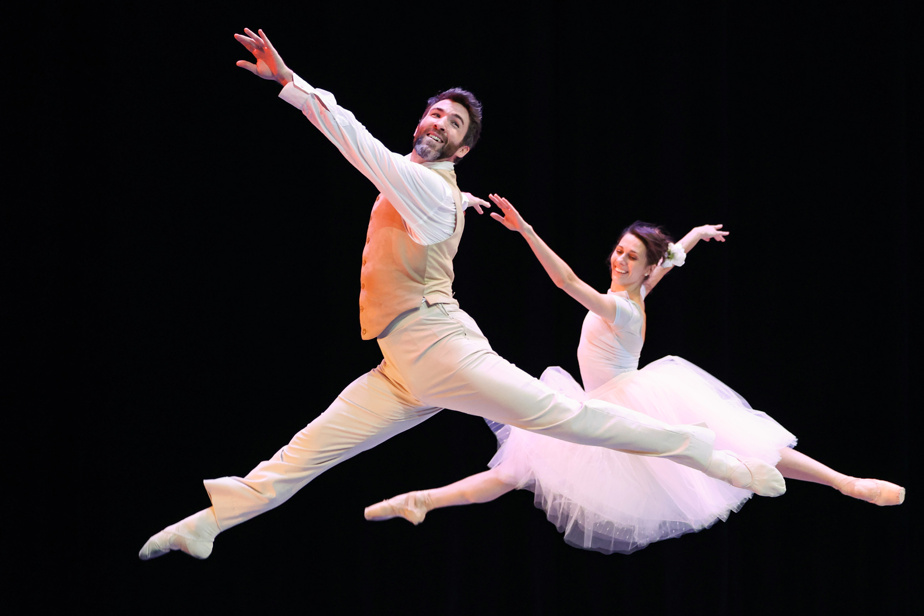The Lady of the Camellias is a classic that we have visited and revisited numerous times, whether in the cinema or on stage. What remains to discover in this work by Alexandre Dumas fils, which tells the tragic love story between the courtesan Marguerite Gauthier and the young bourgeois Armand Duval? The answer: a lot of things.
The character of Marguerite Gauthier is so rich that the choreographer Peter Quanz decided to entrust this role to three dancers, who will illustrate three major stages in the young woman’s life.
“There are extraordinary human beings at the Grands Ballets Canadiens, artists who were chosen not only because they have beautiful proportions and excellent technique, but also because they have great humanity,” explains the Canadian choreographer in interview. So I wanted to offer the extremely complex role of Marguerite to three ballerinas in a single performance in order to show a more fleshed out character, provide a deeper interpretation and present both a great spectacular performance by the Grands Ballets Canadiens and something very intimate. »

PHOTO MARTIN CHAMBERLAND, THE PRESS
Canadian choreographer Peter Quanz
The Lady of the Camellias tells how Marguerite Gauthier agrees to leave Armand Duval, a man she sincerely loves, so that he can continue his career in high society. The courtesan succumbs to tuberculosis without being able to reveal to her ex-friend the extent of her sacrifice.
Alexandre Dumas fils was inspired by his own love story with the courtesan Marie Duplessis to write this novel.
Maude Sabourin, a dancer from Terrebonne, will perform the role of Marguerite in the third painting, entitled The abysswhile she is very ill.
The two previous performers, Rachele [Buriassi] and Anya [Nesvitaylo], begin the adventure and I finish it. So I have to arrive in a state that they have already established. It’s a challenge, it’s quite difficult for a performer, but it’s super interesting to approach this piece in this way.
Maude Sabourin, dancer from Terrebonne
The dancer must soak up the emotion constructed by the two other dancers. “I feed on it to be able to continue production, so that it makes sense, so that I am on the same wavelength with what they have done previously. It’s not easy, but at the same time, it’s inspiring. »

PHOTO SASHA ONYSCHENCKO, PROVIDED BY THE GRANDS BALLETS CANADIENS
Maude Sabourin
It is therefore a question of establishing coherence without losing its personality.
“All three of us play the same role,” continues the dancer. There is a certain teamwork that is done so that we are in the vision of the choreographer, in his understanding of the story, in what he wants to approach as a subject. It’s something that we share, but we each have our definition, our interpretation, our own emotions that emanate from that. »
Feed on the news
The novel by Alexandre Dumas fils was published in 1848, and the person responsible for costumes, Anne Armit, wanted to reflect this era with very romantic outfits. Peter Quanz, however, emphasized that he did not want to limit himself to a single dance language, classical or romantic ballet.

PHOTO MARTIN CHAMBERLAND, THE PRESS
The characters of Armand Duval (Graeme Fuhrman) and Marguerite (Anya Nesvitaylo) in the painting The sacrifice
“I also use contemporary ballet, contemporary dance and even Chinese dance. It’s a series of very contrasting languages which shows that the story is still relevant today,” explains the choreographer.
There is still work to be done to ensure equality for all, to preserve choices in life. In this time when Roe v. Wade [sur le droit à l’avortement aux États-Unis] is in question, women’s rights are current and the story seems relevant to me.
Peter Quanz, choreographer
Peter Quanz also suggested working with works by female composers from various eras, including Lili Boulanger, Fanny Mendelssohn and Clara Schumann. Conductor Dina Gilbert will direct the Grands Ballets orchestra.
Body language
This is a fifth collaboration between Peter Quanz and Les Grands Ballets. The first, with a ballet called Kaleidoscopetook place in 2008.
“It was the first Canadian company that invited me to work in my own country,” recalls Mr. Quanz. It made me love this company, that I am loyal to it and that it influenced my way of interpreting Dumas’ work. »
After a career of nearly 25 years as a professional choreographer, Peter Quanz sees himself as a mature artist.
“What makes me most proud is when the choreography and steps I created with the dancers disappear, when it becomes just body language that everyone can understand on a personal, emotional level. So we go from a pretty ballet, well rehearsed, to something that touches people’s hearts. »
At the Wilfrid-Pelletier room at Place des Arts, from October 19 to 28
